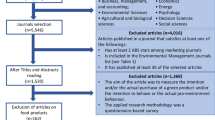Abstract
This article introduces an iterative choice procedure for valuing inland water quality. This approach breaks up the valuation into a series of component tasks. The water quality ladder approach is not valid empirically. Consequently, respondents in Colorado and North Carolina assessed the value of making water quality rated “good” by EPA, which has a value of $22.40 per additional percent improvement. Nonuse and probabilistic use are highly valued. The results also indicate how water quality valuations differ for aquatic environment, edible fish, and swimming, as well as for water that is cloudy, smelly, or polluted by toxics. Minorities are particularly likely to rely upon monitorable water quality attributes.
Similar content being viewed by others
References
Berkman, Richard and W. Kip Viscusi. (1973). Damming the West. New York: Grossman Publishers.
Bishop, Richard C. and Michael P. Welsh. (1992). “Existence Values in Benefit-Cost Analysis and Damage Assessment,” Land Economics 68(4), 405–417.
Bishop, Richard C. and Thomas A. Heberlein. (1990). “The Contingent Valuation Method.” In Rebecca L. Johnson and Gary V. Johnson eds., Economic Valuation of Natural Resources: Issues, Theory, and Applications. Social Behavior and Natural Resources Series. Boulder: Westview Press.
Cameron, Trudy Ann and Jeffrey Englin. (1997). “Respondent Experience and Contingent Valuation of Environmental Goods,” Journal of Environmental Economics and Management 33, 296–313.
Fischhoff, Baruch and Lita Furby. (1988). “Measuring Values: A Conceptual Framework for Interpreting Transactions with Special Reference to Contingent Valuation of Visibility,” Journal of Risk and Uncertainty 1(2), 147–184.
Keeney, Ralph L. and Howard Raiffa. (1993). Decisions with Multiple Objectives: Preferences and Value Tradeoffs. Cambridge: Cambridge University Press.
Magat, Wesley A. and W. Kip Viscusi. (1992). Informational Approaches to Regulation. Regulation of Economic Activity Series No. 19. Cambridge: MIT Press.
Magat, Wesley A., W. Kip Viscusi, and Joel Huber. (1988). “Paired Comparison and Contingent Valuation Approaches to Morbidity Risk Valuation,” Journal of Environmental Economics and Management 15, 395–411.
Mitchell, Robert Cameron and Richard T. Carson. (1989). Using Surveys to Value Public Goods: The Contingent Valuation Method. Washington: Resources for the Future.
Mitchell, Robert Cameron and Richard T. Carson. (1993). “The Value of Clean Water: The Public's Willingness to Pay for Boatable, Fishable, and Swimmable Quality Water,” Water Resources Research 29(7), 2445–2454.
Rawls, John. (1971). A Theory of Justice. Cambridge: Harvard University Press.
Schkade, David A. and John W. Payne. (1993). “Where Do the Numbers Come from? How People Respond to Contingent Valuation Questions.” In Jerry A. Hausman ed., Contingent Valuation: A Critical Assessment. New York: North-Holland, 271–293.
Smith, V. Kerry and William H. Desvousges. (1986). Measuring Water Quality Benefits. Boston: Kluwer Academic Publishers.
Smith, V. Kerry and Carol Mansfield. (1998). “Buying Time: Real and Hypothetical Offers,” Journal of Environmental Economics and Management 36, 209–224.
United States Environmental Protection Agency. (1994). National Water Quality Inventory, 1992 Report to Congress, EPA 841-R-94–001.
Viscusi, W. Kip and Wesley A. Magat. (1987). Learning about Risk: Consumer and Worker Responses to Hazard Information. Cambridge: Harvard University Press.
Author information
Authors and Affiliations
Rights and permissions
About this article
Cite this article
Magat, W.A., Huber, J., Viscusi, W.K. et al. An Iterative Choice Approach to Valuing Clean Lakes, Rivers, and Streams. Journal of Risk and Uncertainty 21, 7–43 (2000). https://doi.org/10.1023/A:1026565225801
Issue Date:
DOI: https://doi.org/10.1023/A:1026565225801




